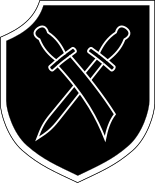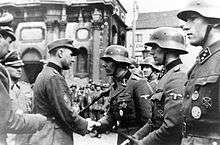Walloon Legion
| Walloon Legion | |
|---|---|
 Insignia of the 28th SS Volunteer Grenadier Division Wallonia, created in October 1944 | |
| Active | 1941–1945 |
| Allegiance |
|
| Branch |
|
| Type | Battalion, brigade and later division-size, though only ever brigade-strength |
| Size | 7,000-8,000 men (total) |
| Engagements | |
| Commanders | |
| Notable commanders | Léon Degrelle |
The Walloon Legion (French: Légion Wallonie) was a collaborationist military formation recruited among French-speaking volunteers from German-occupied Belgium, notably Brussels and Wallonia, during World War II. First raised in July 1941 shortly after the German invasion of the Soviet Union, the unit was supported by the Rexist Party as a demonstration of its loyalty towards Nazi Germany. The unit served on the Eastern Front, initially as a unit of the Wehrmacht and, after June 1943, in the Waffen-SS. Though sustaining heavy casualties, the unit increased from battalion to brigade and eventually division-size before surrendering to the British in April 1945.
Origins
Rexist Party and collaboration
At the time of the German invasion in May 1940, Belgium had several political parties that were broadly sympathetic to the authoritarian and anti-democratic ideals represented by Nazi Germany. In Wallonia and Brussels, the largest of these groups was the Rexist Party, led by Léon Degrelle. This had originated as a faction of the mainstream Catholic Block, but split in 1935 to form an independent populist party. Ideologically, Rex supported Belgian nationalism, but its support for corporatism and anti-communism made it sympathetic towards aspects of Nazi ideology. It achieved some early success, peaking at the elections of 1936 in which it received 11.5 percent of the national vote, but experienced a decline in the following years before the German invasion and remained marginal.[1]
After the Belgian surrender on 28 May 1940, a German Military Administration was created to govern the occupied territory. Preferring a strategy of indirect rule, the administration preferred to work with established Belgian political and social elites, largely ignoring fringe political groups such as the Rexists.[2]
Creation of the Walloon Legion

In order to acquire more influence and German support, Rex attempted to bring itself closer to the occupation authorities. On 1 January 1941, Degrelle announced Rex's total support for the occupation authorities and for the policy of collaborationism. After the German invasion of the Soviet Union on 22 June 1941, it embraced the idea of raising a military unit, seen as "a political opportunity to increase the importance of their movements and eliminate political competition".[3] At the same time, the Vlaams Nationaal Verbond (VNV), a Flemish nationalist and rival authoritarian party in Flanders, also announced its intention to form a "Flemish Legion" to fight in the German Army in the Soviet Union. This move, combined with the Germans' favourable stance towards the VNV, meant that it would not be possible to realise Rex's preferred option of a national "Belgian Legion" on the Eastern Front.
In July 1941, Rex announced that it would raise a unit of volunteers of its own, dubbed the Walloon Legion (Légion Wallonie). The unit would form part of the Wehrmacht because Walloons were not considered sufficiently "Germanic" to enlist in the Waffen-SS.[3] Recruitment initially met with little success, leading Degrelle personally to volunteer for the unit as a private. In total, some 860 men had volunteered by August 1941, bringing the unit up to the strength of an infantry battalion.[4] Dubbed Infantry Battalion 373, it was sent for training in Meseritz, Germany. As part of Degrelle's ideal of an expanded Burgundian-style Belgium, the unit adopted the Burgundian cross as its insignia.
Initially, most of the volunteers came from the cadres of Rex and in particular its paramilitary militia, the Formations de Combat. In propaganda, Rex emphasised the anti-communist nature of the conflict and argued that collaboration was compatible with Belgian nationalism.[5] Initially, the unit encountered various internal problems with some volunteers being unwilling to swear allegiance to Adolf Hitler and others being classed as medically unfit: almost a third of the volunteers were repatriated before October 1941.[6]
Eastern Front
Early actions in the Wehrmacht
The Walloon Legion fought its first engagement against Soviet forces on 28 February 1942 as part of the 17th Army in the Ukraine. It suffered heavy losses and was reduced to 150 men within its first months. It continued to encounter "enormous losses" throughout 1942.[7] Its record in combat, however, was widely exploited in propaganda and increased Degrelle's legitimacy in the eyes of the German leadership, especially Heinrich Himmler who commanded the SS. In late 1942, Himmler declared the Walloons to be a Germanic race, paving the way for the unit's incorporation into the Waffen-SS on 1 June 1943. The Walloon Legion was re-organised into an SS brigade-sized unit of 2,000 men, known as the SS-Sturmbrigade Wallonia (SS- Sturmbrigade Wallonien).[8]
The high attrition rate within the Walloon Legion required increasing focus on recruitment. A second recruitment drive was started in February 1942, recruiting 450 new volunteers of whom many came from Rex's small youth wing. A third "frantic" campaign in November 1942 raised a further 1,700 men. These recruitment drives weakened many Rexist institutions by diverting manpower away from projects in Belgium. However, Degrelle became increasingly keen on the political potential of the Walloon Legion which he saw as a more effective political tool than the Rexist Party in Belgium.[7] As the war continued and the pool of Rexist members fell, the volunteers became "largely non-political ‘adventurers’ or desperate men", often drawn from the urban working class and the unemployed.[9]
Actions within the Waffen-SS

In November 1943, the new unit was again deployed to the Ukraine in response to the Soviet Dnieper–Carpathian Offensive. There, the brigade fought as part of the SS Wiking Panzer Division in the Korsun–Cherkassy Pocket in February 1944 and suffered 70 percent casualties.[10] A detachment also fought at the Tannenberg Line in Estonia in June 1944, suffering heavy losses. Degrelle, however, was widely celebrated for his role in the battle at Cherkassy and received the Knight's Cross, becoming "the poster boy for all European collaborators".[10] The remnants of the unit returned to Belgium where parades were held in Brussels and Charleroi in April 1944.
In the aftermath of the Allied Liberation of Belgium in September 1944, Degrelle managed to increase the brigade to division-size by drafting members of the Rexist Party and Walloon volunteers from the paramilitary National Socialist Motor Corps (NSKK). The 28th SS Volunteer Grenadier Division "Wallonia" (28. SS-Freiwilligen-Grenadier-Division Wallonien) was created in October 1944, but only numbered approximately 4,000 men, making it considerably understrength.[10] French and Spanish soldiers from the Legion of French Volunteers Against Bolshevism (LVF) and Blue Division were folded in increase its numbers. The "division" saw action during Operation Solstice in February 1945 and was forced to retreat through Central Pomerania near Stettin on the Oder river. After mass defections in April 1945 the remaining personnel of the unit fled to Lübeck where they surrendered to the British Army.
Altogether, between 7,000 and 8,000 men served in the Walloon Legion between 1941 and 1944, slightly less than the number of Flemish who served in comparable formations. Some 1,337 were killed.[11] Fearing execution, Degrelle escaped to Denmark and Norway and then fled to Francoist Spain where he remained in exile until his death in 1994.
References
- ↑ Wouters 2018, p. 261.
- ↑ Wouters 2018, pp. 262–263.
- 1 2 Wouters 2018, p. 266.
- ↑ Wouters 2018, p. 267.
- ↑ Wouters 2018, pp. 266–268.
- ↑ Wouters 2018, p. 270.
- 1 2 Wouters 2018, pp. 271–272.
- ↑ Wouters 2018, p. 272.
- ↑ Wouters 2018, p. 286.
- 1 2 3 Wouters 2018, p. 273.
- ↑ Wouters 2018, p. 274.
Bibliography
- Wouters, Nico (2018). "Belgium". In Stahel, David. Joining Hitler's Crusade: European Nations and the Invasion of the Soviet Union, 1941. Cambridge: Cambridge University Press. pp. 260–87. ISBN 978-1-316-51034-6.
Further reading
- Conway, Martin (1993). Collaboration in Belgium: Léon Degrelle and the Rexist movement, 1940-1944. New Haven: Yale University Press. ISBN 978-0300055009.
- De Bruyne, Eddy (1991). Les Wallons meurent à l'est: la Légion Wallonie et Léon Degrelle sur le Front russe, 1941-1945. Paris: Didier Hatier. ISBN 9782870887400.
- Littlejohn, David (1972). The Patriotic Traitors: A History of Collaboration in German-occupied Europe, 1940-45. London: Heinemann. ISBN 0-434-42725-X.
- Plisnier, Flore (2011). Ils ont pris les armes pour Hitler: la collaboration armée en Belgique francophone. Brussels: Renaissance du Livre. ISBN 9782507003616.
External links
- Légion Wallonie at Belgium-WWII (Cegesoma)